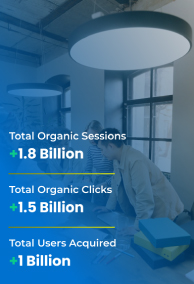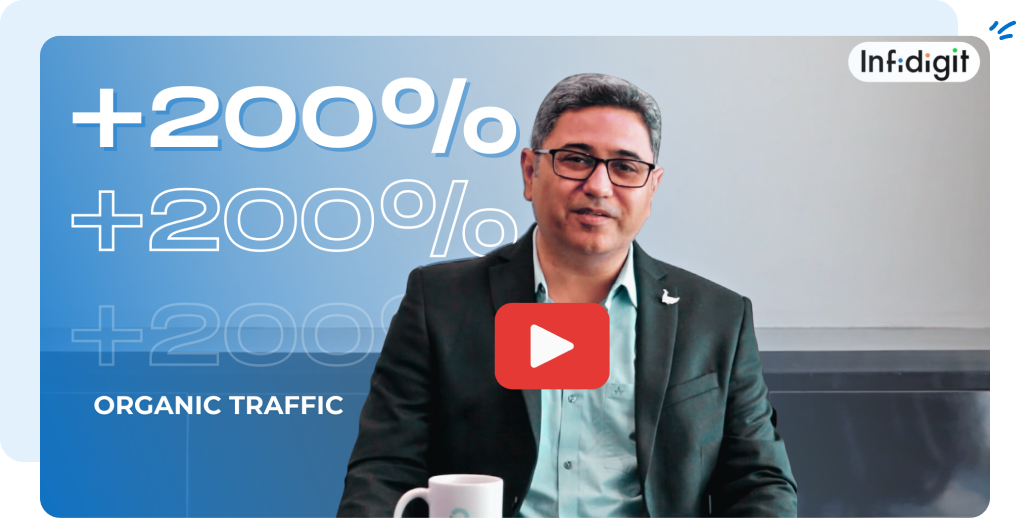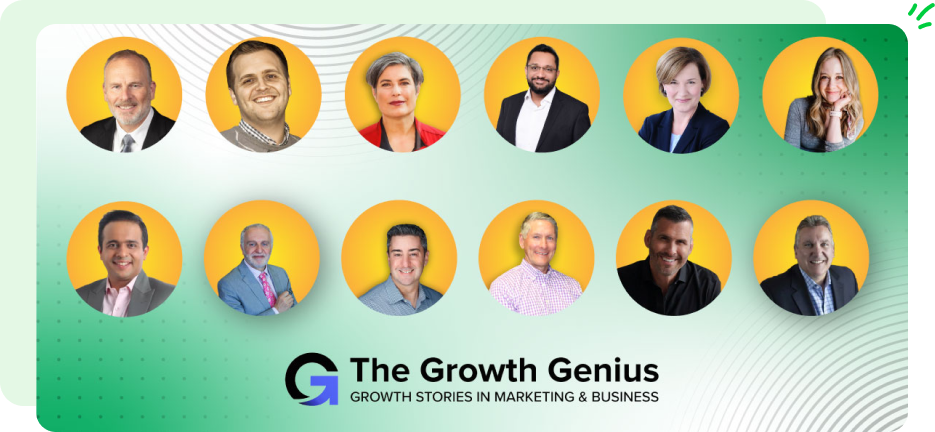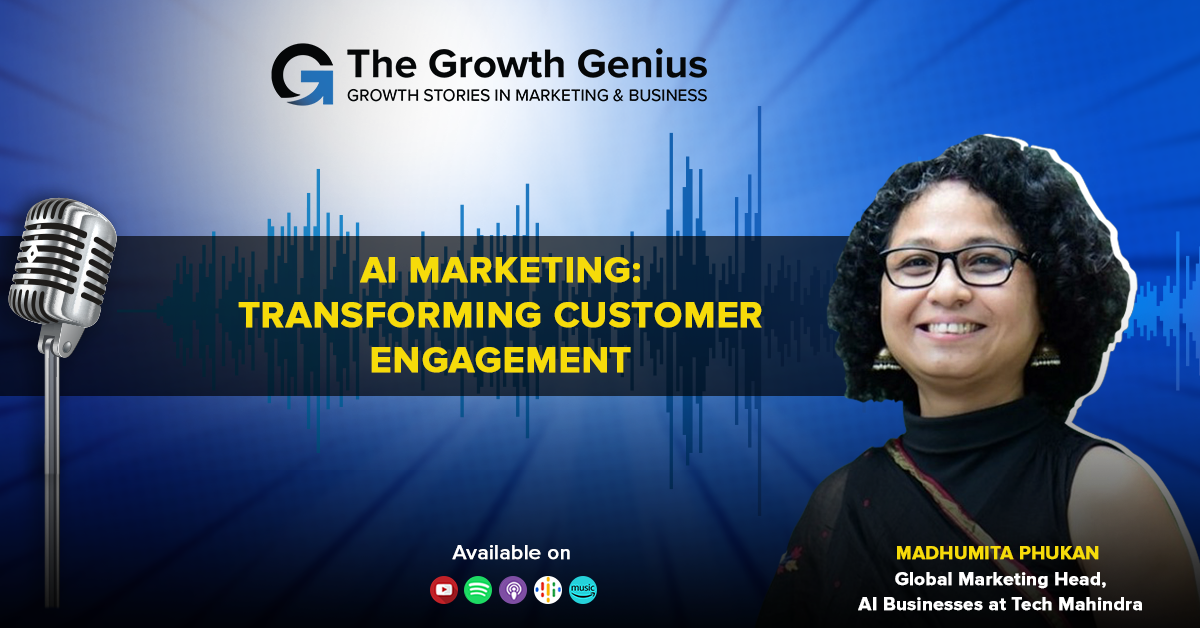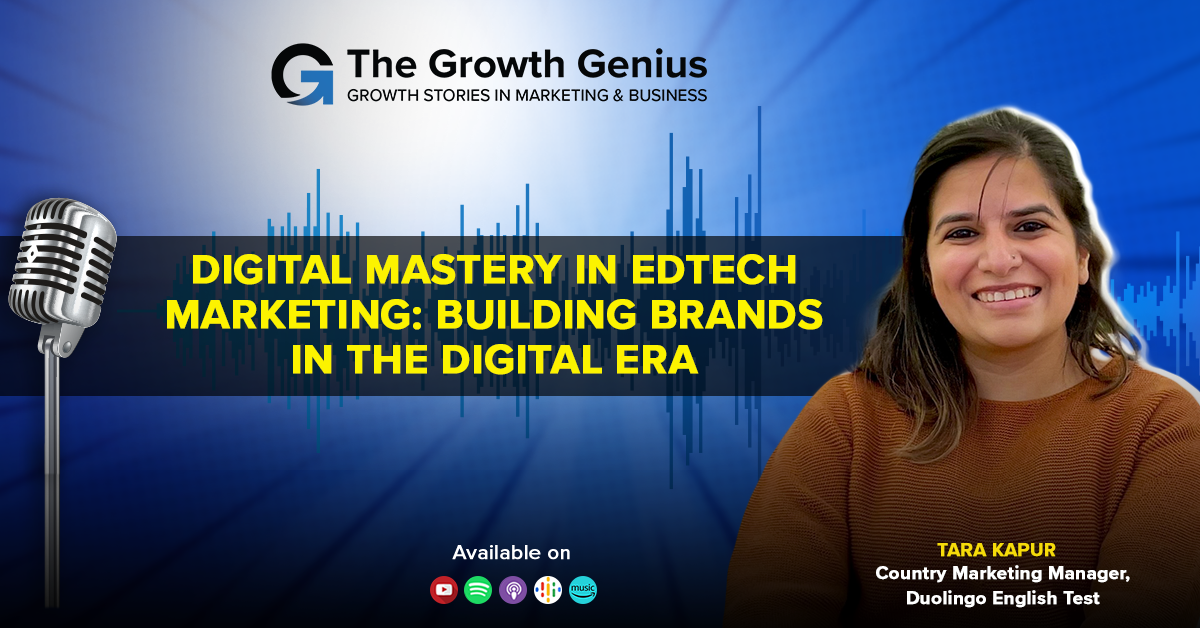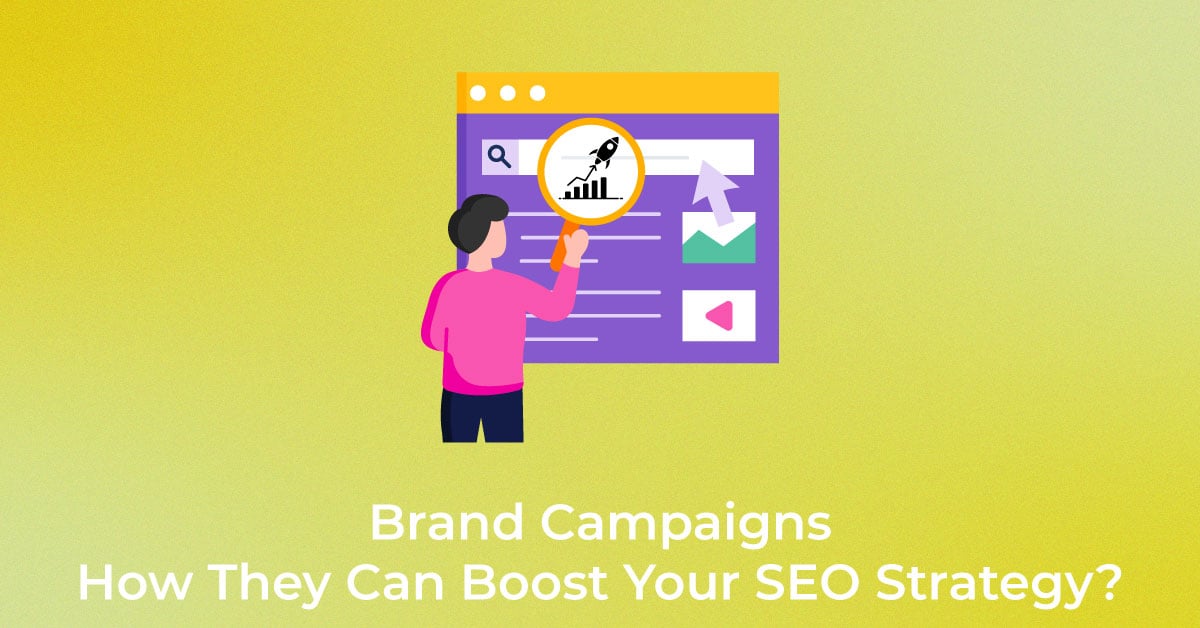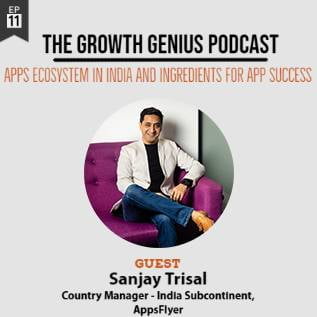
Witness an Increase in your ROI
Unlock higher rankings, quality traffic, and amplified conversions through tailored award-winning SEO strategies.
Summary
In the podcast episode on app ecosystem in India, the focus is on the ingredients for app success. The discussion highlights the importance of understanding the Indian market and its unique challenges. It emphasizes the need for localization, user-centric design, and effective marketing strategies to stand out in the crowded app market. The experts also stress the significance of building a strong app ecosystem by collaborating with other apps and platforms. They provide insights into the key factors that contribute to app success, such as user engagement, monetization strategies, and continuous improvement based on user feedback. Overall, this podcast episode offers valuable advice for app developers looking to thrive in the Indian app ecosystem.
Key Take Aways
8 Key Takeaways for a Digital Marketer from this Blog:
- Understanding the Indian App Ecosystem: The blog provides insights into the Indian app ecosystem, helping digital marketers understand the market dynamics and user behavior in India.
- Growing Smartphone Penetration: With the increasing smartphone penetration in India, digital marketers should focus on mobile-first strategies to reach a wider audience.
- Localization is Key: To succeed in the Indian app market, digital marketers need to localize their apps by adapting to regional languages, cultural nuances, and preferences.
- User Experience Matters: Providing a seamless and user-friendly experience is crucial for app success in India. Digital marketers should prioritize optimizing app performance and usability.
- App Store Optimization (ASO): Implementing effective ASO strategies is essential to improve app visibility and rankings in app stores, increasing the chances of app downloads.
- Leveraging Social Media: Utilizing social media platforms to promote apps and engage with the target audience can significantly boost app success in India.
- In-App Monetization: Digital marketers should explore various monetization models, such as in-app purchases, subscriptions, and advertisements, to generate revenue from their apps.
- Continuous Analysis and Optimization: Regularly analyzing app performance, user feedback, and market trends is crucial for digital marketers to identify areas for improvement and optimize their app strategies.
Overall, this blog provides valuable insights for digital marketers to navigate the Indian app ecosystem and maximize their app’s success in the country.
Optimise your mobile app with our award-winning ASO strategies that will lead to higher rankings & installs on Play Store & App Store.
Do you want to boost your
mobile app performance?
Optimise your mobile app with our award-winning ASO strategies that will lead to higher rankings & installs on Play Store & App Store.
In episode #11, the country manager at AppsFlyer India, Sanjay Trisal, breaks down how mobile apps have contributed towards the evolution of the digital ecosystem in India and abroad. He talks about how and why he jumped from blue-chip companies like Dell and Ingram Micro to the startup ecosystem.
Sanjay has consolidated AppsFlyer’s business in India by building strong teams across customer success, sales, support, marketing, finance, and partner development. He helped AppsFlyer in acquiring over 85% market share, with the highly coveted enterprise accounts comprising 95% of its customer base.
So, let us join today’s Growth Genius Sanjay Trisal and our host – founder and managing director of Infidigit, Kaushal Thakkar, where they talk about the importance of mobile apps for your business and how it has changed the digital ecosystem.
Fundamentally, there are four major components for a digital ecosystem. And I think apps stay at the core of it. Core components for this digital ecosystem being user profile or users of the internet, the digital service industry per se, the innovative startups and the NEGP, which is the National e-Governance Program.
Read Transcript
[00:17] Kaushal: Welcome friends to The Growth Genius powered by Infidigit. My name is Kaushal Thakkar, I’m the founder of Infidigit and your host for the show. Each week, I interview geniuses who have created phenomenal digital growth; we witness key techniques and share insights to help you learn and create your own growth story. Today we are going to discuss the topic app ecosystem in India and ingredients for app success.
To share these insights, we have Sanjay Trisal, the country head of AppsFlyer. AppsFlyer, the mobile attribution tool is a market leader with more than 70% market share. Being the country head Sanjay has witnessed the growth of the ecosystem in India very closely during the last many years. Let’s learn more about apps from this growth genius. Hi Sanjay, thank you so much for being on the Growth Genius show. How are you doing today?
[1:12] Sanjay: I’m doing good Kaushal. How are you doing?
[1:14] Kaushal: Doing wonderful. Thanks a lot for being a part of the Growth Genius and you are in Bangalore how is the weather out there today?
[1:22] Sanjay: If there is anything that you can envy about Bangalore, it’s weather. It’s been amazing. I think we have very, very pleasant weather right now. Unfortunately, I cannot go out too much, but something to kind of cheer for.
[1:36] Kaushal: Great, that’s really nice. And yeah the days are very near now when we should be pushing this COVID thing behind, and we should be all outback to our normal lives.
[1:46] Sanjay: I hope so. I just hope so yeah.
[1:48] Kaushal: Sanjay, for some of our audience who are not aware about you. Could you help them with a short introduction about yourself?
[1:55] Trisal: Well, surely thank you Kaushal. My name is Sanjay, as you know. I am the Country Manager for AppsFlyer, and I was the first employee for AppsFlyer joined AppsFlyer in 2015. Since then I have been responsible for shaping up various teams across customer success, sales, tech support, marketing and so on. Prior to AppsFlyer, I was with InMobi for about two and a half-three years responsible for building up the Latin America business from scratch. That’s been my stint in the digital ecosystem. I spent a good amount of years initially with blue-chip companies like Dell, Ingram Micro and so on so forth. So I spent about 13 years there before the startup bug bit me and I entered InMobi.
[2:35] Kaushal: And Sanjay, we would like to know more AppsFlyer recently completed five years and tell us more about AppsFlyer as well, please.
[2:42] Sanjay: AppsFlyer is a mobile measurement platform marketing analytics platform, which is a global leader headquartered out of US and Israel. Our product and tech is based out of Israel. The basic premise of the product is providing customers a great tool to make sure that they, you know, can do their ROI analysis, can measure the campaigns that they are running and do deep analysis onto their campaigns and measure the LTV of the customer right from pre-install up to the uninstall level. So that’s what AppsFlyer does.
[3:11] Kaushal: Nice, and quite a few of my customers are also using AppsFlyer, and I was reading somewhere, and I heard that you have almost a major share of the market. Any numbers which you would share with us in terms of the market share which AppsFlyer…
[3:26] Sanjay: Yeah, thank you Kaushal thanks for that question. I think I missed out saying before that AppsFlyer is a global leader. We have upwards of 60 to 70% market share globally, but India’s story is still better and on rise. We started AppsFlyer India as a business in September 2015. I was the first one to come onboard and thereafter responsible for, you know, setting up teams across customer success, sales, marketing, tech support and so on. Our initial interaction with our customers pre-2015 was basically from our headquarters doing business remotely in India. And that’s when we thought looking at the potential that India offers; it was the right time to make sure that we do investments in India and work in the customer environment right now based in India setting up offices in India. So that’s how I started.
I in fact, remember a funny incident when I joined AppsFlyer, and my CEO said that “hey you know what, we have you on board now can we make our market share 50%?”. I said “wow, that’s interesting. But can you tell me what’s the market share now?” “Ah, we don’t care,” that’s the expectation we have. So that sounded to be a very, very, very high.
I don’t know whether he was serious or not though but it sounded like a very high number to kind of reach for. And unlike what most of the sales gurus or some of my mentors at that point in time suggested, you know we need to have a lot of salespeople on ground and so on and so forth. I instead focused on making sure the customers that we have in place like whatever limited customers back then in 2015 we had, we wanted to make sure that they get this AppsFlyer experience that we are known for globally. Making sure that we serve and cater them on time every time, and that’s been my mantra always, cater, respond every time and make sure that you solve for their problems as and when they occur. And that’s what we believed in. And I went in investing in customer success before we hired anybody in the sales front. In fact, my first sales hire was in 2017, which is two years later, once the company was formed in India.
[5:18] Kaushal: You were all hands-on in terms of sale in that case. Heading the country, and also taking up that huge responsibility of increasing the…
[5:26] Sanjay: In fact, what we did well, was making sure to understand our customer pain points. And as I said, catering to customer needs on time, every time, so that helped us win customers that helped us win confidence in the customers’ hearts. And when those customers moved to other places, because they had such a great experience, they took us along everywhere, right? So that’s the beauty of a relationship that you make. So it has been a great working experience with this set of amazing guys. Fast forward 2020 where we are now, if you look at various third party reports, whether it is Safe DK or App Annie and so on and so forth the peg of our market share at AppsFlyer India, market share was between 75 to 85% market share.
It doesn’t matter whether it’s 75 or whether it is 85. I think by any stretch of imagination in four and a half years; it’s a good market share to have. But what I want to highlight here Kaushal is that AppsFlyer in India out of whatever market share you kind of look at even if we were to take that with a grain of salt, the higher percentage of our existing customers is enterprise like off the market share that we have, I think close to 90% customers will be enterprise customers.
[6:28] Kaushal: Wow really good. And that’s a really great growth story from the place where there was absolutely the CEO didn’t have a number to mention when you asked the market share to 50% which was the target and here you are almost at around 80-90% market share at the enterprise level. Really good, that’s nice. And Sanjay since you’re speaking more about the apps. Today, I would like to start with the core discussion and start with this question around the digital ecosystem. India has evolved a lot, and so has the digital ecosystem along with it. But how is the app story viewed around the digital ecosystem?
[7:03] Sanjay: I think it’s a great question. Many people ask me how have apps evolved because of the evolving digital system? I think you gave it a little bit of a twist by how is the digital ecosystem evolving because of apps? I think it’s a great question. See fundamentally; there are four major components for a digital ecosystem in India or otherwise. And I think apps stay at the core of it. Four components for this digital ecosystem being user profiles or users of the internet, the digital service industry per se, the innovative startups, and the NEGP, which is the National e-Governance program. Now if you look at any of these parameters, now let’s look at users of the internet or user profile.
Today, India has about 500 million or upwards of 500 million internet users. Okay? If you look at the CAGR growth has been about 40% from the last 12 to 14 years, but the major inflexion point happened around 2012-13. And that was the time of course apps existed before that, but that’s when we got a huge push in the system. Storage consumption per user used to be, you know, the overall storage consumption used to be in terabytes, which is today about 17,000 petabytes if you look at April to June 2019 quarter. So that’s the huge amount of storage capacity that’s been consumed by users today. Why essentially? Because most of these users are on various forms of apps.
Let’s look at the digital service industry. A huge efficiency has been driven by the digitization of offline to online services. One of the examples that comes to my mind offhand is the digital payment system. Like, think of the time when people had to stand in a queue in the bank for money transfer, doing any banking transactions like that, everything today is happening on the click of a button. If digital as a service industry is about 200 billion today, about 660 million of that is FinTech. So that’s the amount of contribution that FinTech brings in into the digital ecosystem, and there are many more such industries which have transformed offline to online whether it is commerce or travel or so and so forth. Again, apps being at the core of this usage, right?
The third one I said about was the innovative startups. Now, look at tech startups that have happened in the last 10 to 12 years. In 2010, there were a handful of tech startups that probably had raised about half a billion dollars, about 550 million dollars what they had raised in 2010. Today, we have about 9000 or more tech startups, which raised funds of about $14.5 billion, and most of these tech startups are in the app domain. So which means whether it is OTT, education, or edutainment, or finance or travel, or utilities, everything’s based around apps. So the app is at the core of each of these components that I said. I’m not talking about the National e-Governance program right now. But that is also one of them. Aadhar or Aryogya Setu app which is happening during the COVID. So everything is based on apps. So I think while we say that, okay apps have evolved in the digital ecosystem or the growing digital story of India, I would say it’s the usage of apps that also has helped to evolve the digital ecosystem per se.
[10:05] Kaushal: True, very true. And that’s something we are going to see a tsunami yet coming in terms of the app usage as the number of internet users and other metrics keep on increasing in India.
[10:18] Sanjay: I think we have just scratched the surface when it comes to that. Look at like 500 million users is a good number. But there’s still so much more to go if you look at…
[10:28] Kaushal: Yeah, lots of headroom out there. And Sanjay, while we speak of the headroom, any information which you could share on the socio-economic indicators, such as employment, education, etc.?
[10:37] Sanjay: We’re going to just zoom out a little bit and, in some cases, we can kind of zoom in. So if you look at you know, in continuation to for example, what I just said about 500 million users. Just look at India as an economy of India as a country that has evolved over the last 15-20 years. There’s a growing segment of you know, what we used to call the lower middle class, middle class and the higher middle class, and there’s a huge shift happening in that people from lower middle class moving into the middle class, and so on and so forth. I think the dispensable income has increased. Okay?
I think your question is predominantly, as you said, targeted towards apps, the mobile literacy has improved, even if somebody is not let’s say English literate, but he would still be able to you know snack to the various apps that he might be using day to day times. So mobile literacy has increased, I think the dispensable income, discretionary spending have increased, and the segment of people are moving. The affordability has increased. And what has happened on the other hand is the cost of smartphones have come down, the smartphone penetration has increased.
I think earlier there was from an app standpoint we would see a lot of apps getting uninstalled because there was less storage space available in the phones. Today at a $100-200 value we have a smartphone which is good enough to cater to a good amount of apps. So there’s a huge shift which has happened from which we were 10-12 years back today. And this is only again, I believe is going to get better because as we move forward, I think internet penetration is going to increase.
The tier two tier-three cities or tier three, tier four cities are going to get more internet-enabled, the cost of smartphones can get further optimised, we will have more and more apps catering to those target segments, which will help those users to you know, do their livelihood or daily day to day jobs. I think this whole economic…socio-economic pattern is shifting towards that right direction. And I’m very bullish about the India growth story or digital growth story in India as a market.
[12:37] Kaushal: Great! Sanjay, you mentioned about the socio-economic factors currently, any changes which you see in terms of these numbers because of the COVID has it accelerated or reduced the growth rate in any manner?
[12:50] Sanjay: Well, Kaushal I think there’ll be hardly anybody who will say that COVID has not affected them. In some cases, I for sure know some of my customers who say that in the hindsight COVID has helped them and I’ll talk about that as we move forward. But it has definitely affected a large chunk of the population, a large group of people or segments in a wrong way or in a bad way. I don’t know whether necessarily it has changed the socio-economic fabric. But again, as I said, zoom in and zoom out, if we kind of zoom in into the COVID period, which essentially started Feb-March onwards, and it’s continuing. I think the discretionary spending during this phase kind of reduced.
And of course, the supply chain management also got down, right? Because we had manufacturing units hit we had automobile hits, we had a lot of those industries hit. So I think the smartphone shipments in this timeframe went back to 2017-18. I was reading one of the reports, so that has come down, people are spending necessarily on essentials. I was reading through this report on some of the search items that people are doing today that most of… and it said that the biggest search during this timeframe was on essentials only. Okay, so people searching for essentials only.
So I think during this COVID phase, and I firmly believe, and this might be my personal opinion. This is a momentary phase. Of course, it hit us all globally irrespective of caste, creed or whatever. But this, what is going to happen in this COVID phase is not what is going to necessarily determine how the business will be done or how people are going to perform over the next period of two-four-six years. I mean, this behaviour may continue, it has given us a lot of learning. And when I think, for example, work from home, we never thought that we’re going to work from home for such a long period of time. We never knew, and we never thought we never fathomed that it’s going to be months for difficulty, and then we can make peace with it. So we have learned a lot of things, and that will stay with us. But somebody’s saying that “oh you know what the socio-economic fabric is because COVID has changed us and everything is going to go down,”I don’t necessarily believe in it.
And my thoughts are based on some data, while we saw a huge dip in the spending of ecommerce or app downloads from February-March onwards in most of the sectors and there are some sectors which we saw growth also we’ll talk about that. But today, there is about a 250% recovery in the ecommerce space. For example, there has been improvement in the utilities vertical. So it’s not necessarily going to stay with us. Of course, it impacted us. But I don’t believe it necessarily is going to stay like that for a very, very long time. I don’t know whether I answered your question correctly.
[15:18] Kaushal: Yes, you did. And that helps us understand that what are the current change are the things which are going because of the COVID. But yeah, we would like to also understand from you that, let’s say in the coming three-four years, what are the other changes that you see because we are at that current number of 500 million. With a population of 1.3 billion people, there’s quite a bit of headroom over there. But what do you think would be the future change if we had to move more closer to the let’s say 90% mobile usage as compared to the population which would be somewhere around let’s say 1 billion or so number, which will be almost a hundred per cent increase from the current 500 million number. So if we had to grow to that particular number in the coming three, four years, what do you think would be the core change in front of us?
[16:08] Sanjay: Yeah, so that’s like a little bit of crystal ball gazing for me.
[16:11] Kaushal: Definitely, that would be everybody but yeah better than you to answer that question.
[16:16] Sanjay: But yeah if I were to kind of you know look things in retrospect to step back, see how the emergence of trend has been, marry it one with as I said socio-economic factors two and the growth. Fundamentally look today we are 500 million internet users, and let’s say about 300-400 odd smartphone users. We are about close to being 1.4 billion population. As I said, some of the things like affordability are increasing. On the other hand, the cost of smartphones is coming down. The usage per se, increasing like smartphones today is not a fancy item to show off. There are people who are making their livelihood out of this device. In most parts of the country, let’s say tier three, tier four and the emerging India which we call Bharat, the new Bharat, mobile is the first touch point for even the internet.
Like I know of my driver who exposed me honestly to a lot of new apps, which I did not know back then, was not exposed to desktop or laptop. Like a large chunk of the population is not exposed to desktop or laptop, their first brush to the internet is through a smartphone device. So smartphone penetration is going to increase. There necessarily is a headroom like it’s not that we have hit the roof there is a huge headroom there. Affordability has increased and the cost of phones has gone down. So, you know, you see everything is kind of complementing each other. I think on top of that, as I said the mobile literacy and usage has increased.
So that makes it from a want to have to need to have kind of a device is how it is going to be. For us to you know kind of how can we further evolve from this is can we have more and more apps catering to tier three tier four segments which is helping them with their livelihood, helping them with their day to day routine tasks and is making their life easier. I think that’s what’s going to further propel the growth further propel the usage of apps and devices.
[18:08] Kaushal: Okay, and Sanjay, when we speak of this all these factors like affordability and others are going to accelerate the growth, do you think there would be any other factors which would restrict this particular growth or any risk which we should be aware of or challenges which you’re seeing?
[18:24] Sanjay: From the growth of the app ecosystem I think that’s what you mean, right?
[18:29] Kaushal: Yes.
[18:30] Sanjay: Okay, yeah so. I think while the future looks bright, it does not mean that we have to get complacent or app developers say, “okay this is all for us to grab”. It’s very important to make sure that these apps are super relevant in the marketplace. You know, for example, fundamentally, it starts with what is the need that you’re solving for? Okay, and what my target segment would be, what’s the scale of that? That’s number one. Second, what is the kind of user interface, UI UX, like how easy is my app across the various target segments to be used and how good of an option for that once that is done then the third thing is India is such a diverse geography you know different cultures different languages different customs different you know, I don’t know festivals so on, and so forth like I don’t know if it’s right to say. Still, I think multiple countries within one country, right? So what works for you in Maharashtra may necessarily not work for you in lets say Assam, Tamil Nadu and so on.
So, if, for example, you are let’s say a news app which everybody wants to consume, but the languages are different, are you making sure that you are catering to these varied language sects? Are you adopting vernacular? Are you using, you know, what do you call apps in different regions that will be adopted by various different discrete sets of people? So I think usability end is also one of the key components. Now, let’s say if you have everything in place okay let’s presume things are kind of taken care of. And now, a marketer or an app developer is looking to grow this further. There are certain challenges in the growth side of this app, you know?
For example, one of the most common growth challenge the app developers are facing is from a fraud standpoint, you know which is there are essentially two types of fraud and I don’t want to get to it but one is there’s a real user, but somebody is hijacking that install for you, and therefore you’re paying for something you should not pay for. And then there is a fabricated or machine-made or bot whatever you want to call it install.
So that’s another deterrent to your growth because it is not necessarily letting you grow to the level where you want to grow. Because what you see as a growth is necessarily a fraud. You know what I mean? So that’s the other challenge that we see inherently in growth. So I think fundamentally, these are some of the things that if an app developer is taking into consideration and luckily we have a solution for all of this, I think there is a growth in the digital ecosystem for the app developer.
[21:06] Kaushal: True! When you were saying the solution, you were speaking more about the fraud-related solution which AppsFlyer would and other tools similar to that would be able to provide, right?
[21:14] Sanjay: Well, yeah so firstly, I think you can definitely look at as I said the target segment and understand what target segment I’m going to cater to, and what kind of an app fundamentally is going to work in that segment? And essentially, what’s the UI that I should use for so that it’s an ease of use. We also addressed the varied geography that India has today. And I’ll just give you one example, which is language-based, and there can be so many more like how can I make it relevant across the length and breadth of the country to inherently when we move to the tech side of things if growth is limited by let’s say, fraud how do avoid that with various anti-fraud tools that are available in the marketplace one will be from AppsFlyer.
[21:55] Kaushal: Got it, fine. And Sanjay, would there be statistics available in terms of how the apps are distributed across sectors in India?
[22:06] Sanjay: We predominantly have apps mostly across each vertical, a large focus at one point in time if you remember huge amounts of money being invested into the ecommerce space at one point in time, that led to the huge growth of commerce as a vertical right? So shopping, whether it was the likes of Myntras and Flipkarts and so on and so forth. Then we saw a huge investment happening in the FinTech space. This was around before and around the demonetisation side. A huge base was evolved in the FinTech space in terms of mobile wallets, that led to the further growth and push around microlending. You know people who are looking for loans and finances, which are not catered by banks or they do not have documents to kind of do that.
So that’s the vertical that kind of scaled over the years we have seen more utility-based, you know, startups coming into place the likes of your groceries and your shipments and your day to day courier services that are taken care of by these apps. So I think it’s pretty evenly divided in terms of the sectoral growth. There might be…and in India, the classical thing is many people you know when I talk to some of my counterparts from outside say, “hey, what is the best vertical in India? What’s the growing vertical in India?” Or sometimes visitors or from outside and I end up doing some friendly chat with them. “What’s the best vertical there isn’t per se I would say something that has consistently been there.”
Like we had a wave when ecommerce was doing well, and then we had a wave when FinTech was doing very well. And then we had a wave with this whole Jio effect you know of data prices coming down, and we saw a huge boom, and that sustained for a pretty long period in the OTT space and entertainment space. The video consumption increased because the cost of data became so low. So that’s how it is. We historically and traditionally have been a gaming shy country, I would say to some extent, of course, I wouldn’t say that gaming does not exist. Of course, it existed, but nothing to the tune of what we see western markets exposed to gaming as a market. But now we see gaming evolving as well. So that’s how I see it.
[21:14] Kaushal: Okay, and over the next few years, do you think gaming would be one of the leading sectors in terms of growth or OTT and ecommerce also may give it an equal competition in terms of growth rate? What do you think about it?
[24:28] Sanjay: See, I think what COVID did was exposed us to things that we necessarily were shying away from or were not exposed to so much. For example, gaming and education, or edutainment, if I call it education and entertainment together saw a huge growth, in fact, April, May, June 2020 during COVID it saw the highest growth in that education space in the EdTech space compared to the last five quarters while most of the businesses were going down, right? So it exposed us, and it made us embrace this technology or this platform while it did with OTT as well. But OTT we’ve been exposed for a long time.
So I think these two things are now going to evolve because people have got used to it. The inner purchases for gaming were one of the lowest in India, and now people have the psyche per se was such that you know I don’t want to spend money on game-like, why do I spend a certain amount of rupees on just crossing a level, I don’t want to do that. I would play 20 times and earn some points and then perhaps possibly cross the level versus paying let’s say $1 to cross the level.
So I think fundamentally, we are slowly seeing shifts on those lines. People have got exposed and used to as I said EdTech and a lot of students are using that, by the way on that thought a matter that comes to my mind in 2019 there were like 250 million KG to 12th students that had enrolled for. If I look at the down funnel completely about 25 million of them were EdTech users education tech users, and only 1 million was edutainment users. And we have already scaled to I think five X this year. Okay, this is a way to grow. Similarly, with gaming. So I fundamentally… sorry long answer, but I just wanted to say…
[26:19] Kaushal: No, that helps. Quite insightful in fact some of the audience who’s looking out for creation of apps or building something new, they now know which sector to target gaming and entertainment is the way to go.
[26:32] Sanjay: These are the two things that for sure I know will grow and fundamentally you can’t go wrong with Bollywood and Cricket in India. That’s why we see the apps that are directly related to it or indirectly in that genre. So they are doing well as well you know look at Dream 11 or look at apps which are directly related to this, which is like Hotstar, or anything surrounding that they’re all doing well. So fundamentally, we know in India, you’re not going to go wrong with Bollywood and cricket for sure. But outside of that, you know what is growing. I can look at the data myself and say that these are the two booming verticals for sure for some time.
[27:06] Kaushal: Nice that’s good. And Sanjay, the next question over there while we see so many international apps being popularly used in India, we don’t see many of the Indian apps, apps which are created in India going global. Do you also see this kind of trend?
[27:25] Sanjay: Well, definitely and this is a great question and a question very close to my heart, Kaushal. I have myself been, you know, in my interaction with the founders and the execs in most of my customer places or prospects, when I talk to them. I’m very keen to know what is their strategy to go global because it gives me enough pride as a fellow Indian to see that most of you know, Indian apps are doing well at the global stage. Unfortunately, it’s not been at that scale right now. But you know, a couple of things that I understand and I’m going to kind of try to put it a little bit in verbatim and then add my coat of understanding of this system.
[28:03] Kaushal: Sure. that helps.
[28:05] Sanjay: One for any app to scale and grow there is a huge amount of cash pile you need to burn okay. I don’t think investors in India today are in that mode or in that DNA of high risk, high reward they want to play little safe and therefore that huge amount of cash piles and letting people say, okay, go international go burn it is not there point number one.
Point number two, India is an open economy unlike any other closed economies, like the Google of India is Google, right so, the Uber of India is Uber and Ola, the Amazon of India is Amazon. So our companies are necessarily directly challenged by international biggies, and they are countering, and you know, kind of working very hard to counter that. So that’s point number two.
Point number three as I said earlier, India is such a diverse vast and big geography, there is so much more to cater and solve for in India itself before they kind of look outside, right? So they believe, and this is what I hear from some of the founders is that if you get it right here with our model, then only you will be able to get it right outside. And it’s such a big mass-market, such a vast market, that it takes a lot to cater to. That being said, Kaushal, I think we’ve seen some of the OTT companies catering to the international market, although that’s necessarily been for Indian diaspora. But it will be, I think, only time when they cater to the foreign audience as well. There are companies I believe like I think Ola ventured into Australia. So yes we haven’t seen many, but I have a strong hunch that it will be only a matter of time. Yeah, it’s only a matter of time not if but when.
[29:44] Kaushal: Great, and Sanjay, a little backwards and go back to the days where if somebody wanted to start a digital business, they would start with the web first and then expand into the app. Now we are seeing many things different like you mentioned some of them already where they are app first, and then the person may consider if they would like to go and consider the web. Is this a good approach of going app first and then doing web? And if yes, why?
[30:13] Sanjay: I think yes, necessarily from an Indian standpoint, as I said in the beginning, there is a huge segment, which is still not exposed to the app ecosystem, or to the digital ecosystem, which is just getting to terms to the digital ecosystem and reaching there. Okay, and in those cases also mobile is the first device that they have their experience on the internet. So that’s the device that’s their gateway to the internet, number one.
Number two for an app developer, to have a good control on the user like a retained experience of the user, it’s far more there on app versus on the web, because the app is there in their device versus whenever the user kind of comes on the desktop and visits your website. Apart from technology, the technical advantages that we have, I think, fundamentally because, through apps, you are going to one reach an audience which has not been reached before. The audience that will necessarily come to you through the app as a platform only my suggestion would be that it’s a good approach.
[31:19] Kaushal: Great, and Sanjay, would there be any particular growth story of an app, which has grown really well while you would have witnessed several of those stories, could you share one or two of those stories with our audience?
[31:32] Sanjay: There are a couple from Latinmany from India. So there was this there was this game built out of guys out of college in Buenos Aires, and this was a trivia app, and they would kind of cater to the audience. They divided it into various education subjects: science and arts and whatever, you know, things like that. So that app became pretty popular in no time.
And it was one of the highest revenue grossing apps. But coming back to India, I think my last five years I have seen, you know, some of the companies, which were then not making a huge impact and sounded to really, you know, for example, food delivery. Imagine five years, six years back food delivery was not so common, right. So, but I think it’s one of the lifesaving, I would say in most cases app that’s what some of my bachelor colleagues tell me, it’s one of the lifesaving apps for them. So that’s been I think that’s something that stood out. In the education space, we have seen… and education always remains core and close to my heart, because it is solving for that essential need. I think the two things that we kind of need to… that people fundamentally will not go wrong with if they’re solving for is education and health because these are two things, which India really, really needs a lot of help on. Any amount of innovation will not be… we will not say that, oh, this is enough, and we don’t need to do more.
There’s so much more that we have to do more. So there have been many in the OTT space that we’ve seen a humongous amount of growth in the last three to four years. There have been many it’s so difficult to pick one, but I would say vertical wise or sector wise groceries…like seven years back people were reluctant to kind of buy groceries there, you know fresh vegetables and stuff like that. But that’s doing so well today. So yeah, bunch of those I would say.
[33:22] Kaushal: Okay, I love the way you dodged my question Sanjay over there but this is the way I also do it when any of my new prospects is asking me for questions around my client growth rate or something like that so appreciate that thanks a lot for that. But yeah, I have my answer that okay, at least apps around food delivery, education, health, OTT are doing well thanks.
[33:42] Sanjay: Thank you.
[33:43] Kaushal: That’s the way I would have done, fine. Let’s move to the next question over there, which I would like to ask based on our discussion, any suggestions you gave quite a few for the app developers over there, but any suggestions for the brands for creating successful apps, we learned a little about the target segment UI UX, when you mentioned the challenges, would those itself be the suggestions which you will give to the brand? Or is there something else which you’d like to share with the brands?
[34:09] Sanjay: Well, in my opinion, however philosophical it might sound, it is actually, if a brand is solving for the critical need of the customer or its user. And I would say, it’s important to know what you’re solving but more important would be around why like what I am doing my belief in why I’m doing that? And if you have an answer for that, I think that will create your first connection to the user.
So if you have the story, right, like you believe in something I know of some of my friends who said, you know what, I want to start my startup, just with an exit in mind but I would want to start a startup but with an exit in mind. I don’t necessarily believe that’s a great way of doing business and you’re going to solve anything, because that’s when you’re thinking about yourself. If you start thinking about the user at the core of your strategy, that’s when you come up with the product that will be able to help that user right? And if you get that, right, I think things will fall into place. So it’s very important to understand who my user is, what their problems are, what am I going to solve for? Do I believe in it? And what’s the best way to go about that? So that’s, as I said, it might sound philosophical, but that’s on the high level.
[35:20] Kaushal: Start with the why always
[35:21] Sanjay: Start with the why, yes good. And necessarily, once they are into the business, I think it’s very, very important to make sure you know, and I’m giving this example from an Indian context. Again, the users are so diverse. If you are catering to one small… depending on your growth path. I mean, you might want to start do a litmus test. But the scale that you can operate on in India is humongous. Sounds like a pitch, by the way, I’m sorry, but there is so much scale that you can cater to. And if you are able to cater to different regions, different languages, different cultures and still have your offering at the core; I think that will be a clear recipe for your success.
[36:04] Kaushal: Thanks. Thanks, Sanjay for sharing that. We learned a lot about the apps. Now we would love to learn a little more about yourself. So my next question would be in terms of who do you follow?
[36:16] Sanjay: Good question. Well, I don’t know, fortunately, or unfortunately, I don’t know there hasn’t been a single person’s personality that I have followed all through my life. It depends on what stage and mindset a frame of mind I am in. I would want to see somebody who has passed through that stage have done things and have faced the same things.
And what did he do I try to read about him and how they possibly kind of encountered that situation, or what did they do to overcome that or how did they tackle that situation? There hasn’t been one single person I know at one point in time, I would read Steve Jobs a lot during the COVID time I read [Indiscernible: 36:52] couple of books and so on so forth, to give me a little more rational reasoning. I read and hear Sadhguru sometimes, but yeah, it depends.
[37:03] Kaushal: Sadhguru, that’s my favourite too. And Sanjay over the last few years, you have really grown well, right from that portion where you were manager handling few of the key accounts to this particular stage where you’re handling the entire country for AppsFlyer. What makes you remain, so growth focused?
[37:22] Sanjay: I think my…firstly whatever we have achieved is I believe 100% in it is the amount of hard work that the team put it in. We believed in one common goal. And we believed in making sure that we are all one ingredient that I always found while hiring people and looked for was, are we customer-obsessed? And so therefore so it’s fundamentally about people and then our customers with whom we worked, and they challenged the status quo and helped us stay nimble-footed growth-focused. So I think fundamentally that’s where this whole growth comes from, but necessarily if for me to stay growth-focused. I love the feeling of you know, when you hit a milestone that gives me that gives me some different high. I can’t explain it in words. So that’s been on the back of my mind. But that’s what kind of helps me stay focused.
[38:20] Kaushal: So that enjoyment that you get when you are hitting a particular milestone which has been set, and milestone after milestone achieving those things constantly is something which keeps you on the growth path.
[38:31] Sanjay: That’s right.
[38:32] Kaushal: Sanjay, and my other question out over there is a situation where let’s say consider that if you could time travel at this particular moment, what suggestion would you give to yourself at the start of your career or to your younger self? Would you have done anything different?
[38:49] Sanjay: That’s a great question. Okay so I think truth be told when I started my career early on I was a little clueless kind of a guy, I had my own brush up with failures, there was a story that I kind of learned and then implemented. And this is the suggestion it’s a great learning. So I was once attending a talk by Harsha Bhogle, who has come as a motivational speaker, and he gave an example. I don’t know how much cricket you follow. But he said this is like many, many years back. He said, there’s Michael Clarke of Australia when he was a newcomer he came in with a lot of promise and potential. At the same time, we had a batsman from Bangladesh; I think Mohammed Ashraful, not the one now but before who had come both were compared neck to neck with each other.
But a few years later, Michael Clark went off to become the great sensation that we know and captained Australia. Unfortunately, the other gentleman could not survive or scale through to that level. Essentially, the message he was giving is that it’s always important like it doesn’t matter what potential you have, it’s always important to make sure that you’re surrounded by a champion team. And for that meaning necessarily in our parlance, what I would say is that if you are surrounded by a group of people who will coach and guide you to do well, that opens a few horizons for you, and you kind of think through that’s, that’s what I if I were to time travel, I would not look at failures, but to concentrate on people who are around me and try to learn from them a little more.
[40:22] Kaushal: Great, that’s wonderful. Sanjay now we will move to the Speed It round. I would request you to keep the answers a little short. Any particular quote that you live by
[40:32] Sanjay: There are two if I am allowed.
[40:34] Kaushal: Sure.
[40:35] Sanjay: So I try to tell this to my people every time, and I try to remember it myself. Never take success to your head and never take failure to your heart. That’s one. And the other one, which I think is more important, is I read somewhere that “I don’t have the key to success, but I know the key to failure is pleasing everyone”.
[40:52] Kaushal: Okay, thanks. If not apps, what would you be doing?
[40:56] Sanjay: I have a great fascination for teaching when I say teaching, I love spending time with kids from underprivileged parts of the society. I would spend time there more often other than the charities yeah.
[41:09] Kaushal: Great, wonderful. Any daily habit that has been a game-changer for you?
[41:14] Sanjay: I think during COVID I picked up gardening. I always wondered, like how people do gardening, how do they know what to do, what to mix and things like that. I just picked it up. And I believe it’s been a great fun field, a very heartening experience. And it’s amazing to see how a plant like life experience., grows into flowers and things like that. It’s been amazing. It keeps me very positive.
[41:41] Kaushal: Great define Sanjay Trisal in one word.
[41:44] Sanjay: Resilient and indefatigable.
[41:46] Kaushal: Oh great and Sanjay, how can our audience stay connected with you?
[41:50] Sanjay: I think the most common one is LinkedIn. That’s where I am and I try to be as responsive and on time as much as I can, that’s the place where… l
[42:02] Kaushal: Sanjay, we learned a lot from you today, right from being… a lot about the apps over and above that some personal key takeaways which I have is to always start with why being customer obsessed and being surrounded with a champion team. So those are some of the learnings which I take away with me. And I’m going to remember that always when I remember about you, but any other parting thoughts, which you would like to share with our audience?
[42:27] Sanjay: I think what COVID has taught us is definitely to be resilient. And this is not going to stay as you know a pandemic, we will definitely come out of it. So look at the brighter side of things. That’s what I would want to say. I mean, I’m not here to give any ‘gyaan’ but staying positive, looking at things which are there on the horizon. We need to do things which are not to our liking, but we still need it. The choice is ours do we kind of crib and sulk as we do that or do I enjoy the process?
I think if you enjoy doing even if we have to do things that we do not enjoy doing, the trick is to “fake it till you make it.” You might pretend you’re enjoying it till it becomes a habit as they say that your mindset becomes your action, your action becomes your karma, your karma becomes your habit. And your habit becomes the character that you are very important to have a positive mindset and look at things holistically.
[43:23] Kaushal: Definitely, and more importantly, in the current times where we know that the silver lining in this dark cloud is already around us now, a little more of positivity would change the entire situation around us. Thanks a lot for sharing that Sanjay and it was wonderful having you with us on this particular show. It was a great experience, and we had great learning. Thanks a lot for sharing your insights with us.
[43:49] Sanjay: Thank you so much Kaushal for inviting me over. It’s been a great learning experience for me as well to share whatever I know with you. I really appreciate you taking out time and spending with me. Thank you so much.
[44:02] Kaushal: Thanks, see you soon.
[44:03] Sanjay: Thank you.
[44:07] Kaushal: Thank you so much for listening to this episode of The Growth Genius. I hope you learned something today that would help you to grow. If you did, please share this episode with your friends and family. If you’re listening to this on the Infidigit website, I would request you to use the podcast app on iPhone or download Google Podcast or Spotify on your Android phone. Subscribing to this podcast will ensure that you get the episodes regularly on your phone. The podcast icons near the audio streaming widget on the Infidigit website should help you to navigate to the show on your podcast app. Also, if you haven’t yet, please subscribe to the Growth Genius show wherever you’re listening to this podcast. Thank you so much for listening. Now go out there and create growth for yourself and your company. Thank you
Contact Information:
Genius, Sanjay Trisal
https://www.linkedin.com/in/sanjay-trisal-1b60389/
Host, Kaushal Thakkar

Popular Searches
How useful was this post?
0 / 5. 0

